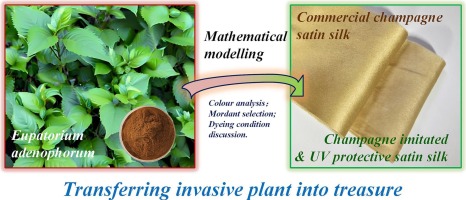Mimicking the champagne colour of commercial satin silk integrating the extract from Eupatorium adenophorum with metal ions – An economic solution to tackle with invasive plants
Xinyue Yan , Yuyang Zhou *
ChinaNational Engineering Laboratory for Modern Silk, Jiangsu Engineering Research Center of Textile Dyeing and Printing for Energy Conservation, Discharge Reduction and Cleaner Production, National Textile and Apparel Council Key Laboratory of Natural Dyes, Jiangsu Key Laboratory of Silk Engineering, College of Textile and Clothing Engineering, Soochow University, Suzhou 215123, China
Reutilizing invasive plants for fabric dyeing and functionalization is a welcomed strategy, which not only tackles with the consequent environmental hazards, but also economizes the organic carbonaceous substances in alignment with the carbon neutralization mission. This study introduces a precise colour imitating strategy for champagne satin silk combining the extract of invasive Eupatorium adenophorum (EAE) with metal mordant. Importantly, a referable approach based on mathematical simulation is developed for controllable mordant dyeing process. Research found that the main components in the EAE are two flavonoids (marigold glycoside and 4′-methyl ether marigold glycoside). The stability of EAE is well remained in water under heating below 100 ℃ for up to 60 min which lays fundamental in its application on textiles. In terms of the mordant types, the silk dyed with EAE/Ti4+ exhibits much closer colour hue to the targeted champagne colour than those with EAE/Al3+ or EAE/Fe3+. The a* and b* value dots are well distributed along with the fitting line indicating their good linear relationship. Such result demonstrates the stable colour hue of EAE/Ti4+ dyed silk, and the colour saturation is manageable by altering the concentration of EAE/Ti4+ couple during dyeing. Based on the established relationship between the EAE/Ti4+ concentration and K/S value, a theoretical mordant dyeing condition (EAE for 72.38 % owf and Ti4+ for 0.81 g/L) is generated to achieve the target K/S value. After washing, the silk dyed with EAE (100 % owf) and Ti4+ ion (0.4 g/L) restricts the K/S variation from 57 % to 16 % compared with the case without mordant. However, over loading of Ti4+ ions reversely reduces the fastness. Additionally, the UPF of treated satin silk exceeds 98. In general, this study establishes a new method for colour imitation of synthetic dyed silk using invasive plant extract, which pushes forward the development of natural dyeing and functionalization techniques.

https://doi.org/10.1016/j.susmat.2025.e01292
